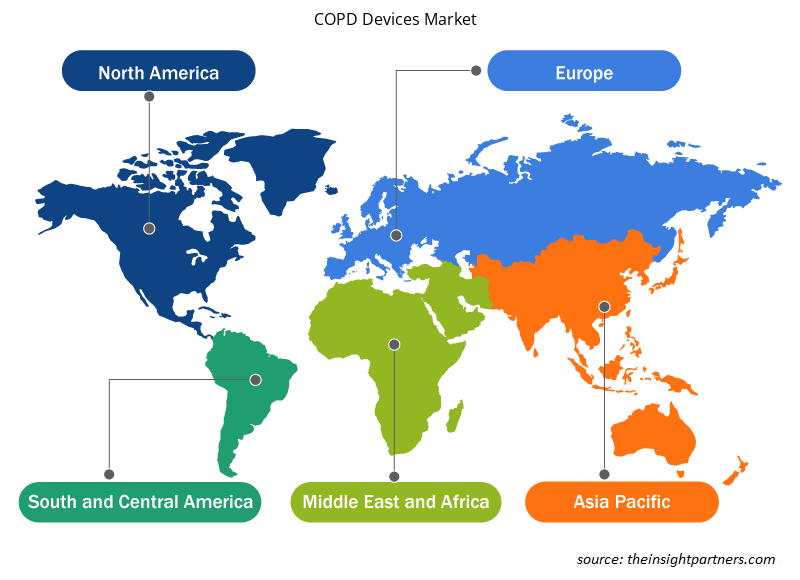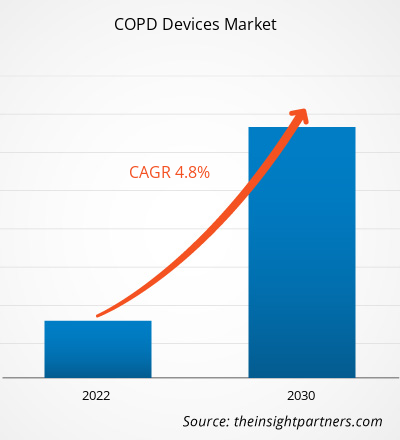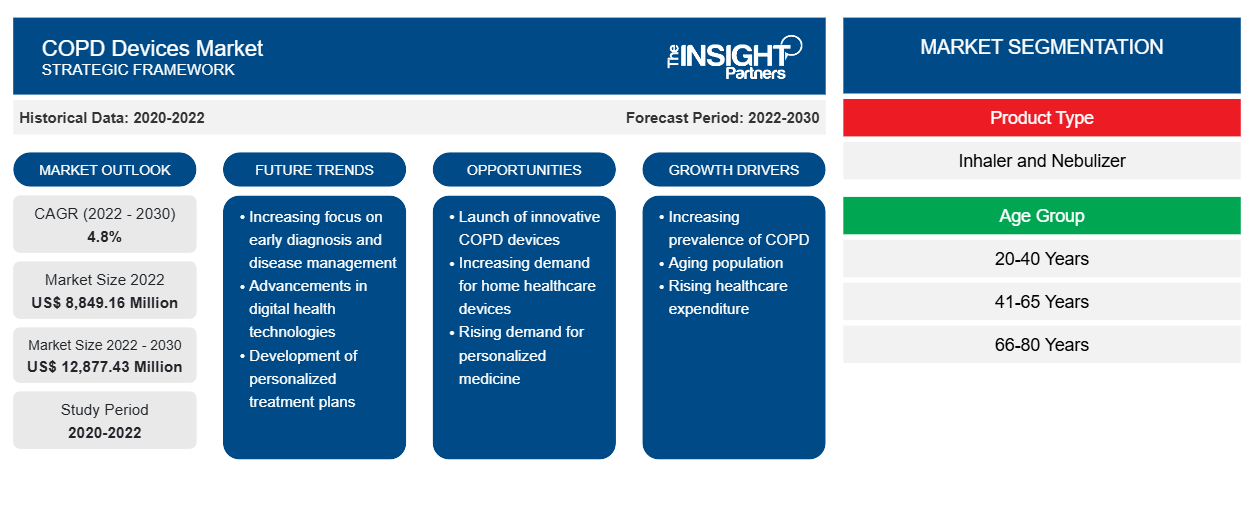[Rapporto di ricerca] Si prevede che il mercato dei dispositivi per la BPCO crescerà da 8.849,16 milioni di dollari nel 2022 a 12.877,43 milioni di dollari entro il 2030; si prevede che registrerà un CAGR del 4,8% dal 2022 al 2030.
Approfondimenti di mercato e punto di vista degli analisti:
La BPCO è una condizione cronica che causa infiammazione polmonare, danneggia il tessuto polmonare e provoca il restringimento delle vie aeree, rendendo difficile la respirazione. Le dimensioni del mercato dei dispositivi per la BPCO si stanno espandendo con le crescenti attività di R&S per sviluppare inalatori intelligenti per il trattamento della BPCO, il crescente numero di casi di BPCO e il crescente sostegno governativo per il trattamento della BPCO. Inoltre, la disponibilità di prodotti avanzati da parte degli operatori del mercato sta ulteriormente guidando la crescita del mercato. Ad esempio, a giugno 2021, Glenmark Pharma ha lanciato Tiotropium Bromide Dry Powder Inhaler, utilizzato per trattare la BPCO nel Regno Unito.
Fattori di crescita e sfide:
La BPCO è una malattia polmonare cronica che causa infiammazione polmonare, con conseguente ostruzione del flusso d'aria dai polmoni. I sintomi della BPCO includono difficoltà respiratorie, produzione di muco (espettorato), tosse e respiro sibilante. Di solito è causata dall'esposizione prolungata a gas irritanti o particolato, il più delle volte dal fumo di sigaretta . Le persone che soffrono di BPCO hanno un rischio maggiore di sviluppare cancro ai polmoni, malattie cardiache e una varietà di altre condizioni. Secondo l'American Lung Association, la BPCO è la principale causa di morte negli Stati Uniti e più di 12 milioni di americani sono stati diagnosticati con queste malattie nel 2022. Secondo la stessa fonte, circa 8,5 milioni di adulti in tutto il mondo sono stati diagnosticati con BPCO nel 2019-2020. Secondo l'Organizzazione mondiale della sanità (OMS), nel 2021, la BPCO è stata la terza causa di morte in tutto il mondo. L'elevato tasso di mortalità della BPCO è dovuto a esacerbazioni acute, che portano all'insufficienza dei muscoli respiratori dei pazienti, con conseguente perdita della capacità del paziente di respirare in modo indipendente; di conseguenza, i pazienti muoiono per infezione sistemica e asfissia. Inoltre, secondo il rapporto Burden of Obstructive Lung Disease (BOLD), nel 2020 si prevede che la mortalità dovuta alla BPCO aumenterà in tutto il mondo nei prossimi 40 anni, raggiungendo circa 5,4 milioni di decessi all'anno entro il 2060. La crescente prevalenza della BPCO a livello globale sta alimentando la crescita del mercato dei dispositivi per la BPCO.
Personalizza questo report in base alle tue esigenze
Riceverai la personalizzazione gratuita di qualsiasi report, comprese parti di questo report, o analisi a livello nazionale, pacchetto dati Excel, oltre a usufruire di grandi offerte e sconti per start-up e università
-
Scopri le principali tendenze di mercato in questo rapporto.Questo campione GRATUITO includerà analisi di dati che spaziano dalle tendenze di mercato alle stime e alle previsioni.
Segmentazione e ambito del report:
Il mercato dei dispositivi per la BPCO è segmentato in base al tipo di prodotto, alla fascia d'età, al canale di distribuzione e alla geografia. Il mercato dei dispositivi per la BPCO, per tipologia, è segmentato in inalatore e nebulizzatore. Il mercato dei dispositivi per la BPCO, per fascia d'età, è segmentato in 20-40 anni, 41-65 anni, 66-80 anni e 85+ anni. Il mercato dei dispositivi per la BPCO, per canale di distribuzione, è segmentato in farmacie ospedaliere, farmacie al dettaglio e farmacie online. In base alla geografia, il mercato dei dispositivi per la BPCO è categorizzato in Nord America (Stati Uniti, Canada e Messico), Europa (Regno Unito, Germania, Francia, Italia, Spagna e resto d'Europa), Asia Pacifico (Cina, Australia, Giappone, India, Corea del Sud e resto dell'Asia Pacifico), Medio Oriente e Africa (Emirati Arabi Uniti, Arabia Saudita, Sud Africa e resto del Medio Oriente e Africa) e Sud e Centro America (Brasile, Argentina e resto del Sud e Centro America).COPD devices market is segmented based on product type, age group, distribution channel, and geography. The COPD devices market, by type, is segmented into inhaler and nebulizer. The COPD devices market, by age group, is segmented into 20–40 years, 41–65 Years, 66–80 years, and 85+ years. The COPD devices market, by distribution channel, is segmented into hospital pharmacies, retail pharmacies, and online pharmacies. Based on geography, the COPD devices market is categorized into North America (US, Canada, and Mexico), Europe (UK, Germany, France, Italy, Spain, and Rest of Europe), Asia Pacific (China, Australia, Japan, India, South Korea, and Rest of Asia Pacific), Middle East & Africa (UAE, Saudi Arabia, South Africa, and Rest of Middle East & Africa), and South & Central America (Brazil, Argentina, and Rest of South & Central America).
Analisi segmentale: Analysis:
Il mercato dei dispositivi per la BPCO, per tipo di prodotto, è diviso in inalatori e nebulizzatori. Nel 2022, il segmento degli inalatori ha detenuto una quota di mercato maggiore e si prevede che registrerà un CAGR più elevato durante il periodo di previsione. Gli inalatori a dose misurata (MDI) e gli inalatori a polvere secca (DPI) sono due tipi principali di inalatori utilizzati per il trattamento della BPCO. A differenza di altri inalatori che forniscono una boccata di medicinale, questi inalatori contengono il medicinale come polvere secca. Il paziente deve inspirare rapidamente e profondamente per far arrivare il medicinale ai polmoni. Gli inalatori a polvere secca sono alternative clinicamente appropriate ed economiche. Gli inalatori a dose misurata (MDI) sono sistemi di inalazione pressurizzati portatili che forniscono direttamente piccole dosi precise di farmaco alle vie aeree di un paziente. I dispositivi MDI includono una valvola e un attuatore che facilitano una somministrazione costante di una dose precisa di medicinale al paziente in particelle di una distribuzione dimensionale esatta erogate tramite un propellente. Questi inalatori richiedono propellenti gassosi con pressioni di vapore che possono essere liquefatti a temperature comprese tra 40 e 70 psi all'interno del contenitore. I combustibili utilizzati in questi MDI per l'inalazione di farmaci devono essere certificati dalla Food and Drug Administration. Dovrebbe implicare l'attuale grado di inalazione Good Manufacturing Practice (cGMP) con elevati livelli di purezza. COPD devices market, by product type, is bifurcated into inhalers and nebulizers. In 2022, the inhaler segment held a larger market share and is expected to record a higher CAGR during the forecast period. MDI) and dry powder inhalers (DPI) are two major types of inhalers used for treating COPD. Unlike other inhalers that provide a puff of medicine, these inhalers hold the medicine as a dry powder. The patient needs to breathe in quickly and deeply to get the medicine into the lungs. Dry powder inhalers are clinically appropriate and cost-effective alternatives. Metered dose inhalers (MDIs) are handheld pressurized inhaler systems that directly provide small, precise doses of medication to a patient's airways. MDI devices include a valve and actuator that facilitates a consistent delivery of a precise dose of medicine to the patient in particles of an exact size distribution delivered via a propellant. These inhalers require gas propellants with vapor pressures that can be liquefied at temperatures between 40 and 70 psi inside the canister. The fuels used in these MDIs for medication inhalation must be certified by the Food and Drug Administration. It should imply the current Good Manufacturing Practice (cGMP) inhalation grade with high purity levels.
Analisi regionale:
In base alla geografia, il mercato dei dispositivi per la BPCO è classificato in Nord America, Europa, Asia Pacifico, Medio Oriente e Africa e Sud e Centro America. Il Nord America è il maggiore contributore alla crescita del mercato globale dei dispositivi per la BPCO. Inoltre, si prevede che l'Asia Pacifico registrerà il CAGR più elevato nel mercato globale dei dispositivi per la BPCO durante il periodo di previsione. La crescita futura di questo mercato sarà probabilmente attribuita alla crescente prevalenza di disturbi respiratori. Inoltre, la broncopneumopatia cronica ostruttiva (BPCO) è un grave problema sanitario negli Stati Uniti. La BPCO è causata dall'ostruzione del flusso d'aria dai polmoni, che può portare a una malattia polmonare infiammatoria cronica. Il fumo è una delle cause principali della BPCO negli Stati Uniti. La crescente preferenza per il fumo negli Stati Uniti sta guidando la crescita del mercato dei dispositivi per la BPCO. Secondo i Centers for Disease Control and Prevention (CDC), circa 14,8 milioni di adulti negli Stati Uniti soffrono di BPCO.COPD devices market is classified into North America, Europe, Asia Pacific, Middle East & Africa, and South & Central America. North America is the largest contributor to the global COPD devices market growth. Furthermore, Asia Pacific is projected to record the highest CAGR in the global COPD devices market during the forecast period. This market's future growth is likely to be attributed to the increasing prevalence of respiratory disorders. Also, chronic obstructive pulmonary disease (COPD) is a major health burden in the US. COPD is caused by obstruction of airflow from the lungs, which can lead to chronic inflammatory lung disease. Smoking is one of the primary causes of COPD in the US. The growing preference for smoking in the US is driving the growth of the COPD devices market. According to the Centers for Disease Control and Prevention (CDC), ~14.8 million adults in the US suffer from COPD.
Inoltre, secondo l'Amministrazione per la vita comunitaria, le persone di età pari o superiore a 65 anni negli Stati Uniti ammontano a 54,1 milioni, il che contribuisce al 16% della popolazione totale e si prevede che raggiungerà il 21,6% entro il 2040. Gli anziani sono estremamente suscettibili alle malattie respiratorie croniche. Pertanto, si prevede che un aumento della popolazione anziana stimolerà anche la domanda di inalatori respiratori durante il periodo di previsione. Inoltre, si prevede che politiche di rimborso favorevoli creeranno diverse opportunità per la crescita del mercato dei dispositivi per la BPCO nella regione.COPD devices market in the region.
Approfondimenti regionali sul mercato dei dispositivi per la BPCO
Le tendenze regionali e i fattori che influenzano il mercato dei dispositivi per la COPD durante il periodo di previsione sono stati ampiamente spiegati dagli analisti di Insight Partners. Questa sezione discute anche i segmenti e la geografia del mercato dei dispositivi per la COPD in Nord America, Europa, Asia Pacifico, Medio Oriente e Africa e America meridionale e centrale.

- Ottieni i dati specifici regionali per il mercato dei dispositivi per la BPCO
Ambito del rapporto di mercato sui dispositivi per la BPCO
| Attributo del report | Dettagli |
|---|---|
| Dimensioni del mercato nel 2022 | 8.849,16 milioni di dollari USA |
| Dimensioni del mercato entro il 2030 | 12.877,43 milioni di dollari USA |
| CAGR globale (2022-2030) | 4,8% |
| Dati storici | 2020-2022 |
| Periodo di previsione | 2022-2030 |
| Segmenti coperti |
Per tipo di prodotto
|
| Regioni e Paesi coperti |
America del Nord
|
| Leader di mercato e profili aziendali chiave |
|
Densità degli attori del mercato dei dispositivi per la BPCO: comprendere il suo impatto sulle dinamiche aziendali
Il mercato dei dispositivi per la COPD sta crescendo rapidamente, spinto dalla crescente domanda degli utenti finali dovuta a fattori quali l'evoluzione delle preferenze dei consumatori, i progressi tecnologici e una maggiore consapevolezza dei benefici del prodotto. Con l'aumento della domanda, le aziende stanno ampliando le loro offerte, innovando per soddisfare le esigenze dei consumatori e capitalizzando sulle tendenze emergenti, il che alimenta ulteriormente la crescita del mercato.
La densità degli operatori di mercato si riferisce alla distribuzione di aziende o società che operano in un particolare mercato o settore. Indica quanti concorrenti (operatori di mercato) sono presenti in un dato spazio di mercato in relazione alle sue dimensioni o al valore di mercato totale.
Le principali aziende che operano nel mercato dei dispositivi per la BPCO sono:
- Società per azioni AstraZeneca
- Beximco Pharmaceuticals Ltd
- Azienda
- Boehringer Ingelheim
- Società per azioni GSK
Disclaimer : le aziende elencate sopra non sono classificate secondo un ordine particolare.

- Ottieni una panoramica dei principali attori del mercato dei dispositivi per la BPCO
Sviluppi del settore e opportunità future:
Di seguito sono elencati i vari piani dei principali attori che operano nel mercato dei dispositivi per la BPCO:
- Ad aprile 2022, GlaxoSmithKline Pharmaceuticals Limited ha lanciato Trelegy Ellipta (fluticasone furoato/umeclidinio/vilanterolo) in India. È la prima terapia tripla a inalatore singolo (SITT) per pazienti con BPCO in un regime di assunzione una volta al giorno. Il prodotto è stato anche approvato dal Drugs Controller General of India (DCGI) per il consumo di Trelegy Ellipta come trattamento di mantenimento per prevenire e alleviare i sintomi correlati alla BPCO nei pazienti di età pari o superiore a 18 anni.
Scenario competitivo e aziende chiave:
Alcuni dei principali attori che operano nel mercato dei dispositivi per la COPD sono AstraZeneca PLC, Beximco Pharmaceuticals Ltd, Getinge AB, Boehringer Ingelheim, GSK Plc, Medtronic PLC, Nephron Pharmaceuticals, Novartis AG, Sunovion Pharmaceuticals Inc e Teva Pharmaceuticals. Queste aziende si concentrano su espansioni geografiche e lanci di nuovi prodotti per soddisfare la crescente domanda dei consumatori in tutto il mondo e aumentare la loro gamma di prodotti nei portafogli specializzati. La loro presenza globale consente loro di servire un'ampia base di clienti, facilitando successivamente l'espansione del mercato.
- Analisi storica (2 anni), anno base, previsione (7 anni) con CAGR
- Analisi PEST e SWOT
- Valore/volume delle dimensioni del mercato - Globale, Regionale, Nazionale
- Industria e panorama competitivo
- Set di dati Excel
Report recenti
Testimonianze
Motivo dell'acquisto
- Processo decisionale informato
- Comprensione delle dinamiche di mercato
- Analisi competitiva
- Analisi dei clienti
- Previsioni di mercato
- Mitigazione del rischio
- Pianificazione strategica
- Giustificazione degli investimenti
- Identificazione dei mercati emergenti
- Miglioramento delle strategie di marketing
- Aumento dell'efficienza operativa
- Allineamento alle tendenze normative























 Ottieni un campione gratuito per - Mercato dei dispositivi per la BPCO
Ottieni un campione gratuito per - Mercato dei dispositivi per la BPCO